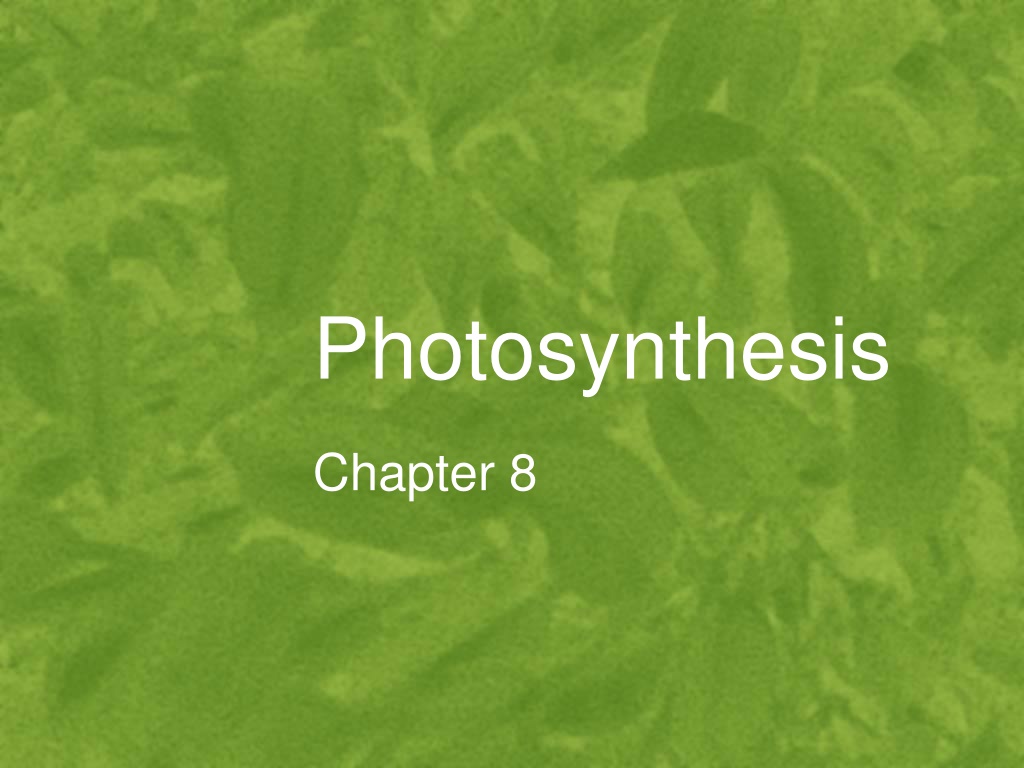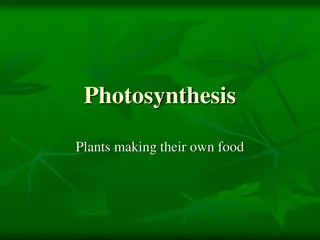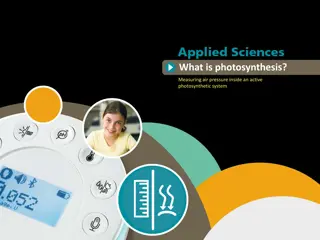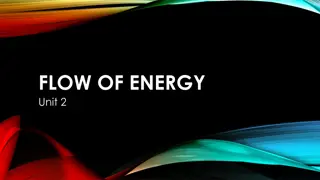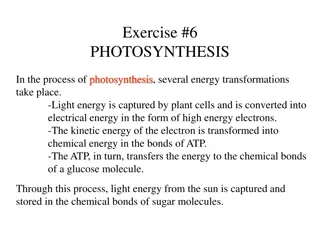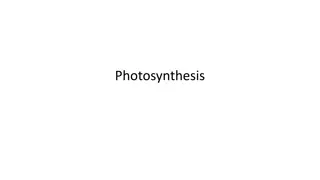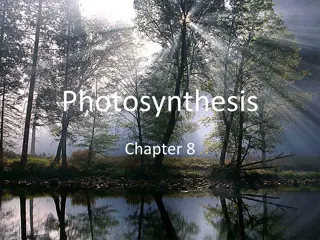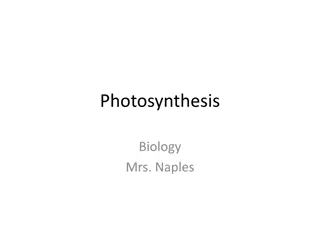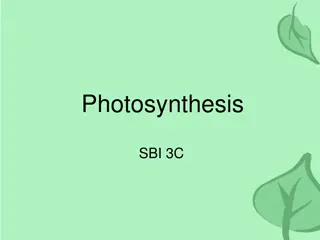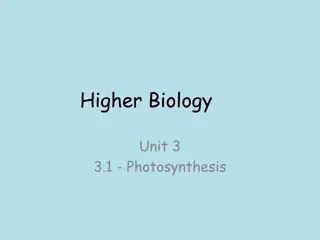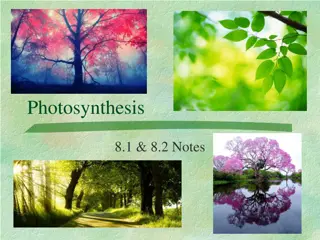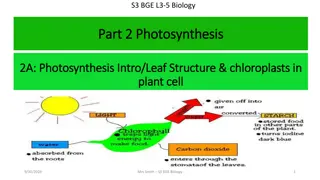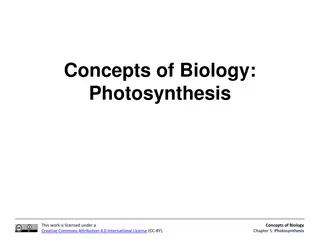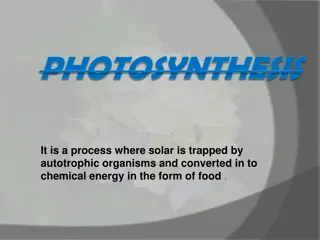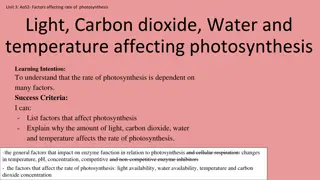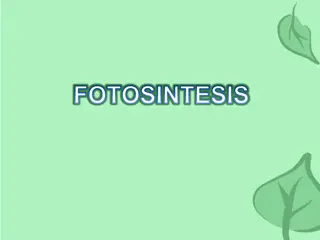Understanding Energy and Photosynthesis in Living Organisms
This content delves into the fundamental concepts of energy in living organisms, exploring topics such as the role of ATP as a chemical fuel, energy storage and release mechanisms, the similarities and differences between ATP and glucose, and the energy sourcing processes of heterotrophs and autotrophs, with a special focus on photosynthesis. Through discussions on cellular energy dynamics and the mysteries of plant growth, readers gain insights into the intricate energy systems that sustain life.
Download Presentation

Please find below an Image/Link to download the presentation.
The content on the website is provided AS IS for your information and personal use only. It may not be sold, licensed, or shared on other websites without obtaining consent from the author. Download presentation by click this link. If you encounter any issues during the download, it is possible that the publisher has removed the file from their server.
E N D
Presentation Transcript
Photosynthesis Chapter 8
In Your Notebook Suppose you earned extra money by having a part-time job. At first, you might be tempted to spend all of the money, but then you decide to open a bank account. 1. What are the benefits of having a bank account? 2. What do you have to do if you need some of this money? 3. What might your body do when it has more energy than it needs to carry out its activities? 4. What does your body do when it needs energy?
Chapter Mystery Read the chapter mystery on page 225. Answer the following in your notebook: Predict how the willow tree gained the extra 75 kilograms in Jan van Helmont s investigation. What process occurring at the cellular level in the plant might be connected to its gain in mass?
8.1 Energy and Life Energy is the ability to do work Cars need fuel Appliances need electricity Do living things need energy? Playing sports Sleeping? Read 3rdparagraph on page 226 Energy comes in many forms .
ATP Adenosine Triphosphate Chemical fuel for our body We use it to store and release energy
Storing Energy ADP Adenosine Diphosphate Contains some energy Like a partially charged battery Add more energy by adding phosphates
Releasing Energy ATP can release and store energy by breaking and re-forming the bonds between its phosphate groups.
In Your Notebook Read Using Biochemical Energy on page 227 in your book. Answer the following in your notebook: With respect to energy, how are ATP and glucose similar? How are they different?
Heterotrophs and Autotrophs Where do living things get the energy they use to produce ATP? Chemical compounds found in food Heterotrophs Eat plants or eat animals that eat plants Mushrooms decompose other organisms Autotrophs Make their own food Use energy from sun to produce high energy carbohydrates - photosynthesis
8.1 Review In Your Notebook Create a newspaper-style comic strip that shows how cells use ATP to get the energy they need to carry out cell activities. Include how ATP molecules store and release energy. Should be at least 3-5 panels long Draw cartoon figures to the best of your ability
8.2 Trapping Energy In Your Notebook Have you ever used a solar-powered calculator? No matter where you go, as long as you have a light source, the calculator works. You never have to put batteries in it. 1. A solar-powered calculator uses solar cells that are found in rows along the top of the calculator. Into what kind of energy is the light energy converted so that the calculator works? 2. Most plants, no matter what size or shape they are, have some parts that are green. Which parts of a plant are usually green? 3. What does the green color have to do with the plant s ability to convert light energy into the energy found in the food it makes?
Chlorophyll vs. Chloroplast Chloroplast An organelle found in plants Chlorophyll A pigment found in chloroplasts Used to capture energy from sunlight Three types Chlorophyll A Chlorophyll B Carotenoids
Pigments Why do leaves look green? Why do they turn colors in the fall?
Chloroplasts Double membraned organelle Has saclike membranes called thylakoids Stacks of thylakoids are called grana Fluid portion is stroma
Energy Collection Chlorophyll is really good at absorbing visible light The energy is quickly and efficiently transferred to electrons Energy levels of electrons gets raised They get excited These high energy electrons make photosynthesis work
In Your Notebook In your own words, explain why most plants will not grow well if kept under green light.
Photosynthesis Overview Photosynthesis uses the energy of sunlight to convert water and carbon dioxide (reactants) into high-energy sugars and oxygen (products). In Symbols 6CO2+ 6H20 lightC6H12O6+ 6O2 In Words Carbon dioxide plus water in the presence of light yields sugars and oxygen
Mystery Clue Answer the following in your notebook: Van Helmont concluded that water must have provided the extra mass gained by the tree. Further studies would prove that he had only half of the answer. What reactant involved in the photosynthesis equation was he not accounting for?
Light-Dependent Reactions Requires direct involvement of light and light absorbing pigments Use energy from sun to produce ATP and NADPH Happens in thylakoid membrane of chloroplast Requires water Provides electrons to get excited Oxygen is byproduct
Light-Independent Reactions No light required Energy from dependent reactions used to make sugars from carbon dioxide Happens in stroma AKA Calvin Cycle
8.2 Review In Your Notebook Choose two of the following elements of photosynthesis: Sunlight Chlorophyll molecule Chloroplast High-energy electrons Light-dependent reactions Light-independent reactions Imagine you are the chosen element and offer a first- person explanation of how you are involved in the process of photosynthesis.
8.3 Factors Affecting Photosynthesis Temperature Enzymes work best at 0o-35oC Too high or too low enzymes break down Light Intensity More light more photosynthesis Eventually reaches maximum Water Source of electrons No water no electrons Also causes tissue damage
Extreme Conditions When hot, must conserve water Plants close stomata so water doesn t escape but that means carbon dioxide can t get in so plant can t make sugars C4 Photosynthesis Don t use traditional Calvin Cycle Allows sugars to be made in intense light and high temperatures Takes extra energy (ATP) Corn, sugar cane and sorghum CAM Plant Only open stomata at night to let air in Pineapple and cacti
Cellular Respiration How do you feel when you are hungry? Weakness is your body s way of telling you that your energy supplies are low. How do you restore those energy supplies? In Your Notebook Read Chemical Energy and Food on pg 250 Look at the analyzing data box on page 251 Answer the questions in your notebook
Cellular Respiration Process that releases energy from food in the presence of oxygen In Symbols 6O2+ C6H12O6 6CO2+ 6H2O + Energy In Words Oxygen plus glucose yields carbon dioxide, water and energy Seems simple, but can t happen in one big explosion has to be controlled so energy isn t wasted
Stages of Cellular Respiration Glycolysis Glucose converted to pyruvic acid 90% of energy still unused Happens in cytoplasm Krebs Cycle Pyruvic acid is broken down into carbon dioxide Also produces very little energy Happens in mitochondria Electron Transport Uses high-energy electrons from glycolysis and Krebs cycle to convert ADP into ATP Requires oxygen as an electron acceptor Happens in mitochondria
Oxygen and Energy Respiration = breathing Cellular respiration = energy releasing pathways in cell Most of the energy-releasing pathways within cells require oxygen, and that is the reason we need to breathe, to respire Two types of respiration Aerobic Cellular respiration that requires oxygen Krebs cycle and electron transport chain Anaerobic Doesn t require oxygen Glycolysis
Photosynthesis vs. Cellular Respiration Photosynthesis removes carbon dioxide from the atmosphere, and cellular respiration puts it back. Photosynthesis releases oxygen into the atmosphere, and cellular respiration uses that oxygen to release energy from food
In Your Notebook Write the equation for photosynthesis. Write the equation for cellular respiration. Explain how these two equations are related. Be sure to identify which equation is which you may use symbols
